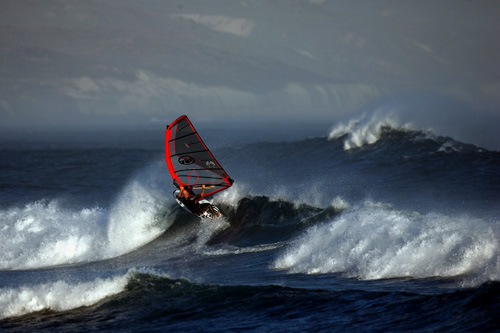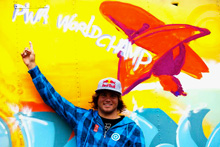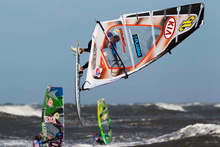
Continuing his fully frontside focus, Jem Hall gets you twisting and shouting as you attack the lip and go vertical.
Now that you’re getting to grips with the top turn you’ll be wanting to get more power back from the wave and use its energy to redirect you more forcefully. To do this you’ll have to get more vertical to present the maximum amount of board to the wave. To go more vertical you’ll need more speed in your bottom turn, and your timing needs to be spot-on to hit the right sections at the right time.
If you need an example of vertical then you’ll find it in the shape of a certain Mr J Polakow, who redefined wavesailing in the ’90s and inspired many of our modern masters of the art. While we now see the likes of goitas, wave 360s and aerials being pulled off on the waves there’s still no better feeling than attacking a lip by going vertical right up into the maw of the beast, smacking it hard on the lip, pausing for breath and making it out the other side. You will work on this part of your wavesailing for a lifetime.
As I’ve said before your bottom turn will be a measure of how well your riding can progress. Your top turn will gain in prowess and performance, but the work you do in the middle of the turn as you open the sail, carve hard and project back up the lip will have you tuning your kit, changing boards, seeking coaching and putting in a large amount of work to get vertical. It’s an amazing journey, and you’ll experience success and failure in equal measure, but from here forwards your mantra will be “attack the lip” or just simply “smack it!”
Basic skills
So far I’ve emphasised the exact placement of your hands on the boom and really moving both head and hands as you ride. I’ve done this to get you more vertical easier and faster, as you’re already doing the basics well.
As you go vert you’ll be calling big-time on the ability to open the sail and shift those hips to the inside of the turn, just as in a step gybe. In fact if you can do a gybe and come out switch-stance in both straps while clew-first and keep speed, then you’ll really keep your velocity when going vertical and make a breakthrough in your riding. I think I’ve said before that how you gybe is how you waveride, so please let’s keep up the quality in this department.
Let’s smack it
Getting technique photos is problematic – more so with waves – and while looking for THE Jedi sequence for this article I just couldn’t find the shots I needed, so in addition to what you see here I implore you to use my Winner to Wavesailor DVD as your visual reference. Doing this and using the very important skill of visualisation will really help you here. As you read these words I want you to see, hear, feel and taste the wave and take the most relevant key points FOR YOU from this article…




